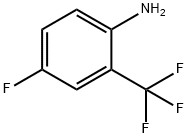2-Amino-5-fluorobenzotrifluoride
Synonym(s):α,α,α,4-Tetrafluoro-o-toluidine;2-Amino-5-fluorobenzotrifluoride
- CAS NO.:393-39-5
- Empirical Formula: C7H5F4N
- Molecular Weight: 179.11
- MDL number: MFCD00007831
- EINECS: 206-886-7
- SAFETY DATA SHEET (SDS)
- Update Date: 2024-12-18 14:08:57

What is 2-Amino-5-fluorobenzotrifluoride?
Chemical properties
clear light yellow to pale brown liquid
The Uses of 2-Amino-5-fluorobenzotrifluoride
4-Fluoro-2-(trifluoromethyl)aniline was used in the preparation of 2-[4-(3-bromophenyl)-7-chloro-6-methyl-2-oxo-2H-chromen-3-yl]-N-[4-fluoro-2-(trifluoro-methyl)phenyl]acetamide.
Properties of 2-Amino-5-fluorobenzotrifluoride
| Boiling point: | 70-72 °C17.5 mm Hg(lit.) |
| Density | 1.38 g/mL at 25 °C(lit.) |
| refractive index | n |
| Flash point: | 162 °F |
| storage temp. | 2-8°C |
| pka | 1.52±0.10(Predicted) |
| form | clear liquid |
| color | Colorless to Yellow to Orange |
| Specific Gravity | 1.380 |
| BRN | 2098758 |
| CAS DataBase Reference | 393-39-5(CAS DataBase Reference) |
| NIST Chemistry Reference | Benzenamine, 4-fluoro-2-(trifluoromethyl)-(393-39-5) |
| EPA Substance Registry System | 4-Fluoro-2-(trifluoromethyl)aniline (393-39-5) |
Safety information for 2-Amino-5-fluorobenzotrifluoride
| Signal word | Warning |
| Pictogram(s) |
 Skull and Crossbones Acute Toxicity GHS06  Exclamation Mark Irritant GHS07 |
| GHS Hazard Statements |
H227:Flammable liquids H302:Acute toxicity,oral H311:Acute toxicity,dermal H315:Skin corrosion/irritation H319:Serious eye damage/eye irritation H332:Acute toxicity,inhalation H335:Specific target organ toxicity, single exposure;Respiratory tract irritation H402:Hazardous to the aquatic environment, acute hazard |
| Precautionary Statement Codes |
P210:Keep away from heat/sparks/open flames/hot surfaces. — No smoking. P261:Avoid breathing dust/fume/gas/mist/vapours/spray. P264:Wash hands thoroughly after handling. P264:Wash skin thouroughly after handling. P270:Do not eat, drink or smoke when using this product. P271:Use only outdoors or in a well-ventilated area. P273:Avoid release to the environment. P280:Wear protective gloves/protective clothing/eye protection/face protection. P309:IF exposed or if you feel unwell: P310:Immediately call a POISON CENTER or doctor/physician. P305+P351+P338:IF IN EYES: Rinse cautiously with water for several minutes. Remove contact lenses, if present and easy to do. Continuerinsing. P403+P235:Store in a well-ventilated place. Keep cool. P501:Dispose of contents/container to..… |
Computed Descriptors for 2-Amino-5-fluorobenzotrifluoride
New Products
(S)-3-Aminobutanenitrile hydrochloride 4-Methylphenylacetic acid N-Boc-D-alaninol N-BOC-D/L-ALANINOL Tert-butyl bis(2-chloroethyl)carbamate 3-Morpholino-1-(4-nitrophenyl)-5,6-dihydropyridin- 2(1H)-one Furan-2,5-Dicarboxylic Acid Tropic acid 1-Bromo-3,5-Di-Tert-Butylbenzene S-2-CHLORO PROPIONIC ACID ETHYL ISOCYANOACETATE 2-Bromo-1,3-Bis(Dimethylamino)Trimethinium Hexafluorophosphate 4-IODO BENZOIC ACID 3-NITRO-2-METHYL ANILINE 1-(2,4-DICHLOROPHENYL) ETHANAMINE (2-Hydroxyphenyl)acetonitrile 4-Bromopyrazole 2-(Cyanocyclohexyl)acetic acid 4-methoxy-3,5-dinitropyridine 1-(4-(aminomethyl)benzyl)urea hydrochloride 2-aminopropyl benzoate hydrochloride diethyl 2-(2-((tertbutoxycarbonyl)amino) ethyl)malonate tert-butyl 4- (ureidomethyl)benzylcarbamate Ethyl-2-chloro((4-methoxyphenyl)hydrazono)acetateRelated products of tetrahydrofuran








You may like
-
 2-Amino-5-fluorobenzotrifluoride CAS 393-39-5View Details
2-Amino-5-fluorobenzotrifluoride CAS 393-39-5View Details
393-39-5 -
 2033-24-1 98%View Details
2033-24-1 98%View Details
2033-24-1 -
 1975-50-4 98%View Details
1975-50-4 98%View Details
1975-50-4 -
 2-HYDROXY BENZYL ALCOHOL 98%View Details
2-HYDROXY BENZYL ALCOHOL 98%View Details
90-01-7 -
 2-Chloro-1,3-Bis(Dimethylamino)Trimethinium Hexafluorophosphate 221615-75-4 98%View Details
2-Chloro-1,3-Bis(Dimethylamino)Trimethinium Hexafluorophosphate 221615-75-4 98%View Details
221615-75-4 -
 61397-56-6 CIS BROMO BENZOATE 98%View Details
61397-56-6 CIS BROMO BENZOATE 98%View Details
61397-56-6 -
 14714-50-2 (2-Hydroxyphenyl)acetonitrile 98+View Details
14714-50-2 (2-Hydroxyphenyl)acetonitrile 98+View Details
14714-50-2 -
 118753-70-1 98+View Details
118753-70-1 98+View Details
118753-70-1
Statement: All products displayed on this website are only used for non medical purposes such as industrial applications or scientific research, and cannot be used for clinical diagnosis or treatment of humans or animals. They are not medicinal or edible.